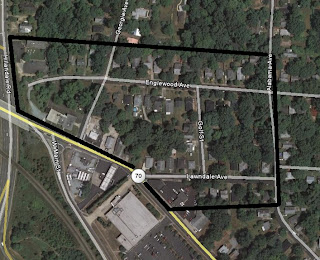I thought I'd start off with a couple of posts on the Hester Heights section of Old West Durham for no particular reason other than that I have friends who live there and I already have a bunch of stuff handy on the neighborhood.
If you've ever looked on the tax card for a house or property in Durham you may have run across some unfamiliar names identifying the subdivision or section of that property (see Tax Record Search link). One such odd identifier, "Hester Heights" appears on properties near Englewood and Alabama avenues in the furthest west section of Old West Durham.

There are over 80 houses in Hester Heights today as well as the old Strawbridge photo studios "oldest school photographers in the south" (not just old school, oldest school). Its boundaries today are less than intuitive and easier to see on am aerial photo (below) than to describe and it's not clear to me if the label Hester Heights was ever commonly used by residents for the area. It seems much more common to hear people living here to refer to themselves as living in old west Durham or Watts-Hillandale.
 Hester Heights today (Google Earth)
Hester Heights today (Google Earth)This lumping in of Hester Heights with larger neighborhood units is not only easier it's also historically appropriate. Until 1913 Hester Heights was part of a series of much larger farm properties dating back to the Revolution. Though it is difficult to say with absolute certainty, the earliest recorded European landowners for that particular area seem to have arrived in the last 30 years of the 18th century. This first family group of German immigrant farmers owned several hundred acres around the Hester Heights site, largely to the north and west. Likely faced with exhausted soil conditions and poor economic prospects the last of the family moved to Indiana in the 1820s and 30s finally selling the last piece of land from afar in 1844 to William Pratt.
I'll be putting up my series of 1850s Durham maps soon which really show the extent of Pratt's landholdings but Gary's
Endangered Durham post on Prattsburg gives one of the best online summaries of his life and legacy in Durham. Pratt bought this parcel of 128.5 acres around today's Hester Heights for $500 and by the end of his life in 1867 he owned well over a thousand acres all around present day Durham. It took years for Pratt's executors to sell off all his land and the Hester Heights property wasn't disposed of until a series of 1872 auctions where a Massachusetts-born business man and speculator snatched up several Pratt properties. Willard had previously been known for financing the first factory in what was then Orange county, now sitting
under water to the north of the Treyburn development. Willard consolidated some of his newly gotten land and flipped it the next year at some profit.
 Willard's plot in 1873 - x near the eastern edge of Hester Heights
Willard's plot in 1873 - x near the eastern edge of Hester Heights
He sold this massive 576.5 acre tract to Simeon J. Hester (1837-1915). Hester was a local Confederate veteran who served in the Orange County Light Artillery for part of the war. He paid Willard $3,459 for the acreage, payable in three yearly installments. Though Hester nearly immediately began selling off some of this acreage, he had certainly acquired a substantial farm. How substantial Hester's property was and the extent to which cadastral lines of the 19th century determine contemporary landscapes can be seen in this edited aerial photo of Hester's purchase:

Note how the eastern boundary jogs around the today's NCSSM (former Watts hospital) and how Hillandale road follows part of the property line south across I-85. In the next post I'll cover a bit more about the subdivision of Hester Heights out of this large parcel and feature a couple of neat Google Earth overlays.

 (From Digital Durham- 2008 street name additions my own)
(From Digital Durham- 2008 street name additions my own)




































